
The capital market waiting game
Bulls and bears both had ample evidence to support their cases coming into 2024. Although inflation has yet to relent to a level that the central banks are comfortable enough to normalize policy interest rates, the global economy has remained remarkably resilient thanks to strong hiring and consumer spending. At this point, the balance can be viewed as tenuous and a push in either direction can be the difference between sticking the landing to a sustained expansion or ending up in a recession.
Policy missteps are not the only points of concern this year. Geopolitical risks remain as elevated as ever in shaping the global economic outlook. The war in Ukraine, renewed tension and conflict in the Middle East, a full slate of global elections, and advances in Artificial Intelligence (AI) all have far reaching impacts that can make their way into supply chains, the health of the consumer, and by extension, commercial real estate markets.
With this backdrop in mind, in this edition of our Mid-Year Real Estate Outlook, we discuss the macroeconomic drivers and risks that we are keeping an eye on and which commercial property sectors we believe have the highest conviction outlook. Understanding the systemic risks and global exposure to unprecedented change is imperative for investors as we head into the back half of 2024.
Economic outlook
Steady but slower
The economic outlook has improved since entering 2024. While risks remain elevated, strong global labor markets and resilient consumer spending have supported a stronger than anticipated expansion.
Real estate investors entered 2024 with a sense of renewed optimism, but the tone has shifted. Stickier than anticipated inflation has pushed potential rate cuts later into the year. To that end, we anticipate slower, but stable growth in 2024.
Growth prospects across regions have begun to converge
Economic outlook for 2024 – 2025
January ‘24 vs July ‘24
Moderating
The U.S. is set to maintain a solid growth trajectory over the next twelve months, ahead of previous expectations.
However, as household savings retrace toward trend levels and corporate debt maturities roll over, the impact of higher interest rates may finally feed through, prompting a downward shift in trend growth and a healthy rebalancing of the labor market.
Europe
Stabilizing
The European economy is on the path to recovery after a period of stagnation. Its growth prospects have improved since the start of the year, although remaining mild, especially in Germany.
Consumer confidence has returned to its pre-Ukraine war level as disinflationary pressure and moderating interest rates continue to revive real income and investment.
Constructive
Growth prospects for Asia Pacific remain broadly positive and have improved slightly, amid resilient domestic demand and stronger exports.
The Chinese economy, however, continues to struggle. Policymakers have ramped up stimulus by lowering borrowing costs and extending subsidies to boost Electric Vehicle sales.
Geopolotics
The global economy is in flux as political tensions escalate
- With the war in Ukraine raging for more than two years and heightened tension around the world, the global economy remains exposed to downside tail risks. Compounding effects of unforeseen geopolitical reverberations have the potential to disrupt major economies that have been balancing on a razor's edge. If these risks find a way to disrupt markets, the path to a soft landing may be compromised.
- For example, an energy price spike driven by a disruption in supply due to a Middle East event would have a significant impact on the economic outlook. Such a scenario would increase consumer prices globally through a spike in commodity and energy prices. While the outcome is not in our baseline forecast, the risk is of interest to the bond market and real estate investors should be aware of the potential impacts as well.
Potential risks and their impact
- Geopolitical risks
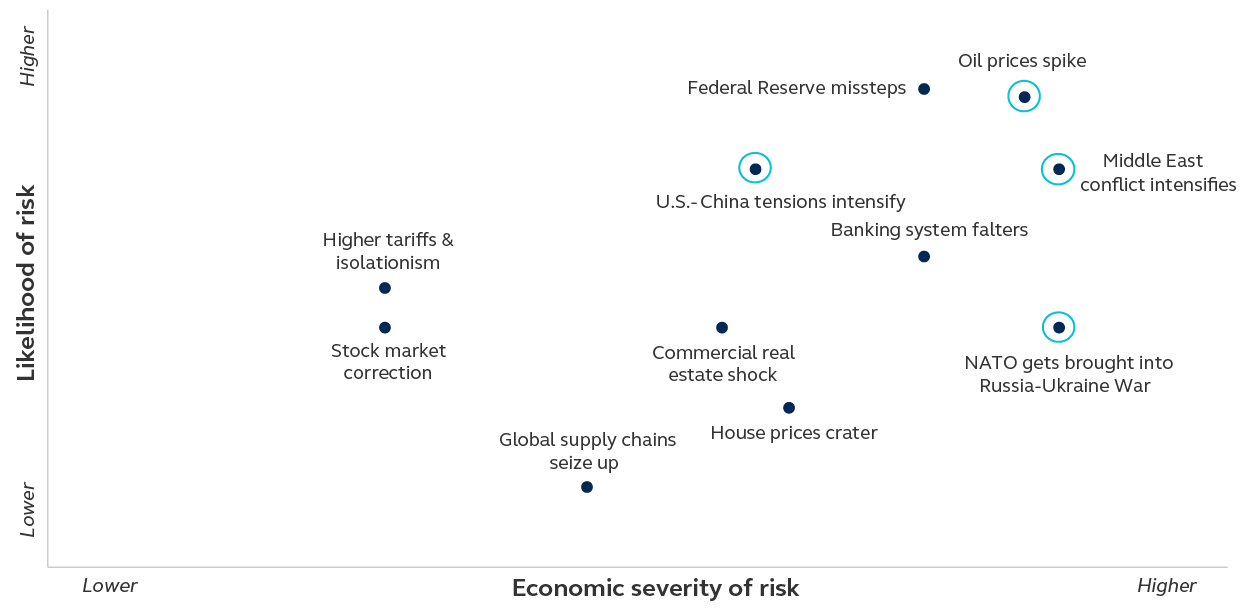
Source: Moody’s Analytics, Principal Real Estate, July 2024.
Real estate
Focus on top performing sectors
Maintain focus on fundamentals to identify sectors with positive outlook
We believe investors should be focused on identifying resilient property sectors that have structural demand drivers that we expect will propel growth going forward. By focusing on the needs of the consumer and the adoption of technology that will define the next era of innovation, we are optimistic that these property sectors will be attractive additions to real estate portfolios.
A lot of ink has been devoted to articles commenting on corrections in the office sector. While we acknowledge a bottom is coming, we do not believe we have seen the full impact of this correction yet. As a result, we have office, and some other property types, in our lowest tier of sectors in 2024. We remain most optimistic about sectors driven by strong structural and demographic growth drivers, such as data centers, U.S. single-family rentals, European hotels, and logistics.
Property sector fundamentals tracker
Based on rental growth outlook, occupancy level, value trends, supply demand imbalance
Source: Principal Real Estate, July 2024. The recommendations above reflect our views on relative opportunities over a 12-month horizon. It is not intended to be, nor should it be relied upon in any way as a forecast or guarantee of future events regarding particular investments or the markets in general.
Data Centers
Data centers demand poised for a new wave of growth, driven by AI
Global data center revenue forecast
$bn and four-year CAGR 2024-2028
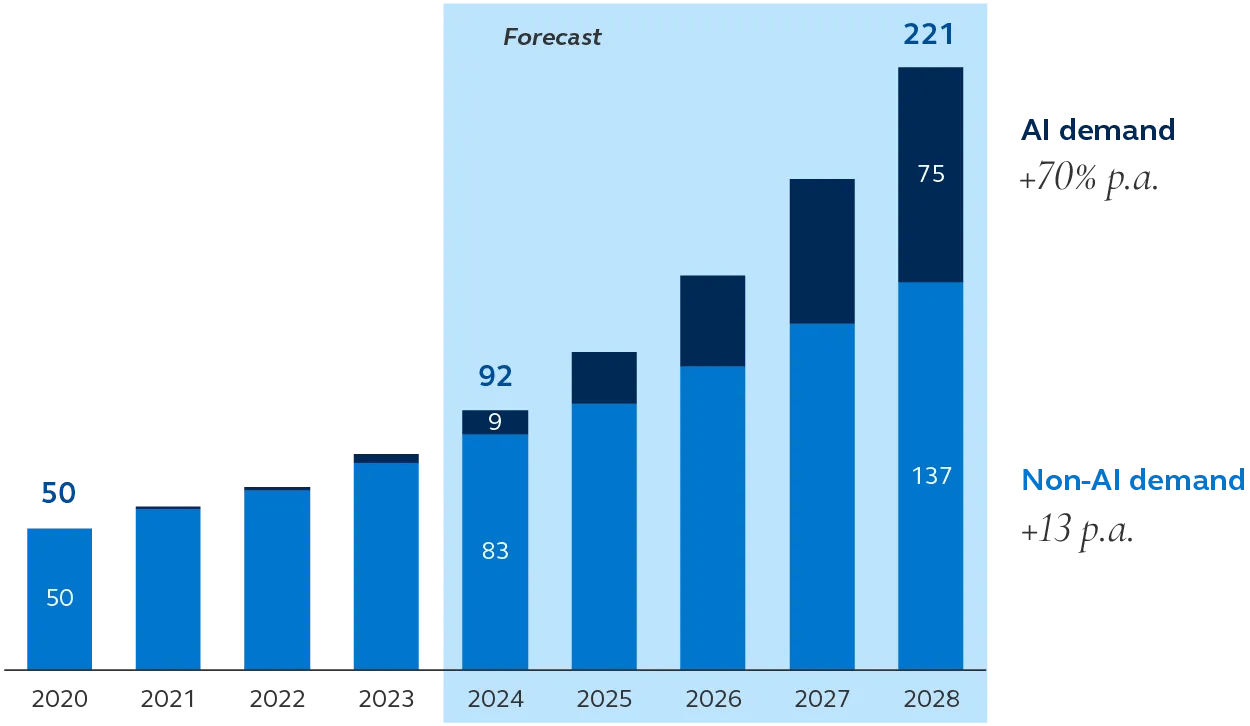
Source: Cushman & Wakefield Research, Structure Research, Principal Real Estate, May 2024
- Globally, fundamentals are strong, rental growth is in the double digits, and vacancy rates are trending to record lows.
- Historically, demand has been driven by streaming services and the migration of enterprise servers to the cloud. Demand from this segment is expected to grow by 13% annually.
- The recent boom in AI has generated an additional layer of demand, which is expected to grow even faster―by 70% per year. Hyperscalers are investing so much capital in this space that by 2027 it is expected that generative AI is set to consume three-quarters of global data center capacity.
- What makes this sector even more attractive is its high barriers to entry as the electricity required for new facilities is simply unavailable. The grids do not have enough capacity to accommodate all the demands. Securing new power is very difficult, with waiting lists that go up to two years in core markets.
U.S. single-family rentals sector offers an attractive price point to traditional apartments
Single-family and apartment rents
Monthly, USD$/unit
- Burns Single-Family Rent Index (Mid Tier)
- Rent (3-Bedroom)
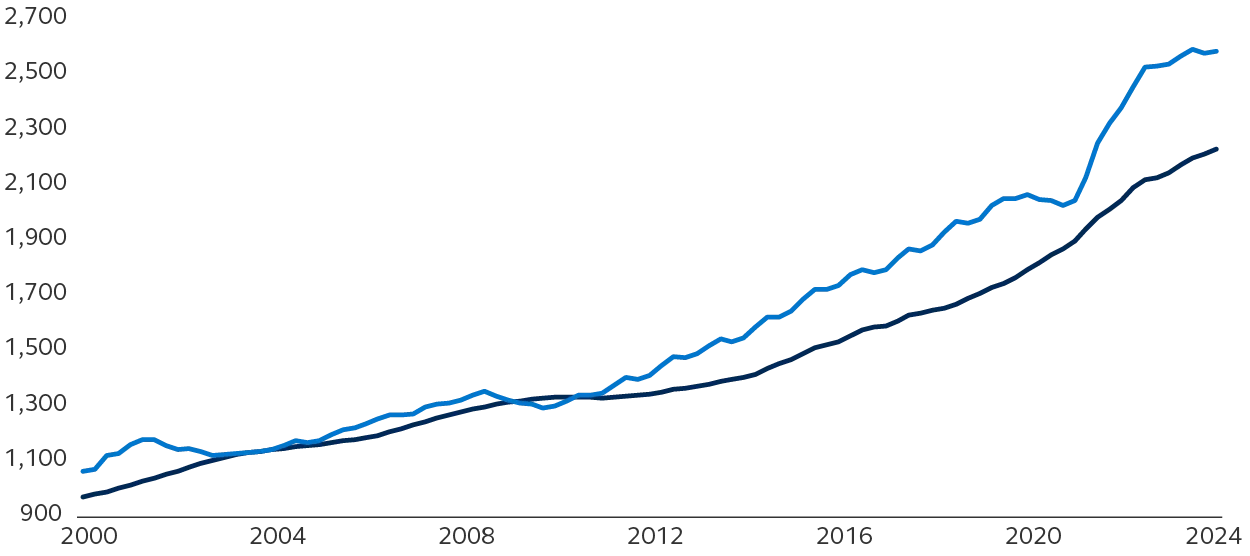
Single-family and apartment rent growth
Average annual percentage change
- Burns Single-Family Rent Index (Mid Tier)
- Rent (3-Bedroom)
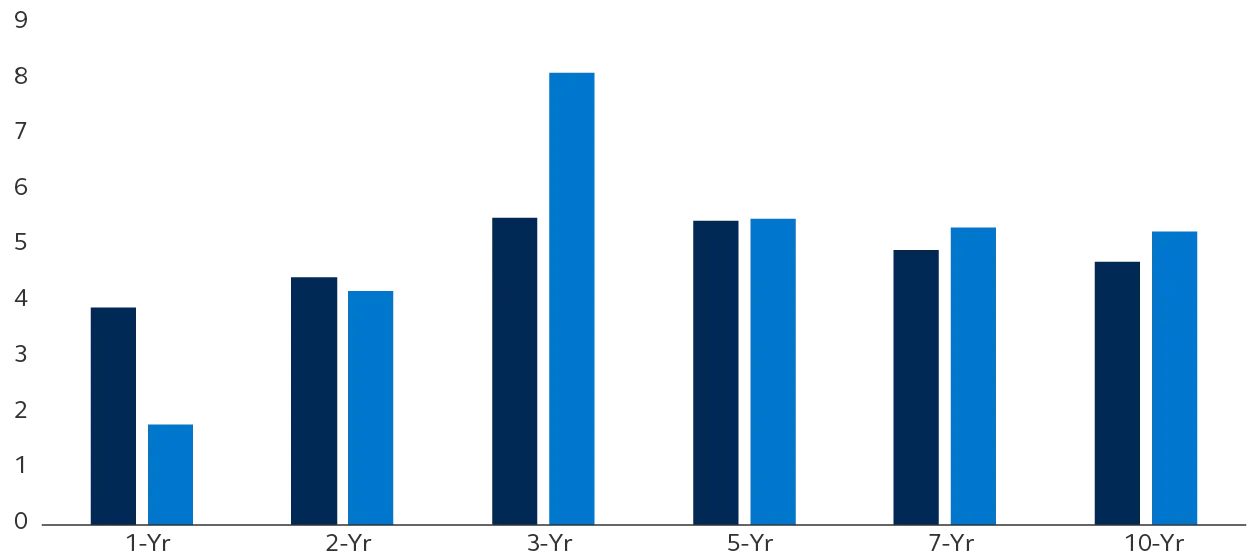
European hotels
The outlook for the European hotel sector looks positive
European air passenger traffic forecast
Percentage change vs pre-pandemic (2019)
- April 2024
- October 2023
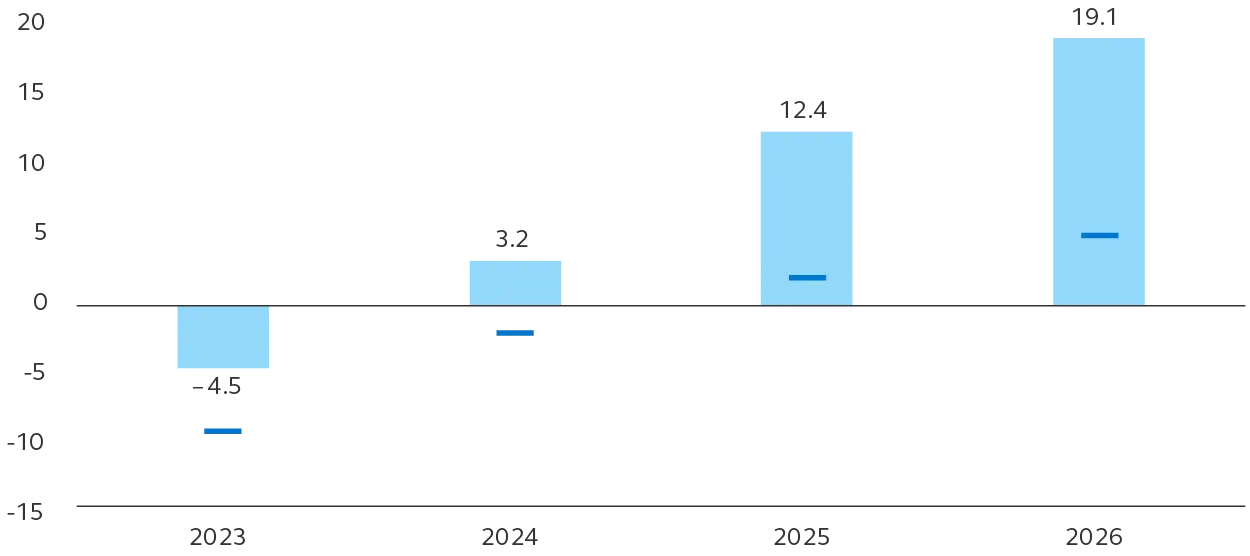
U.S. Logistics
Changes in trade routes and supply chain is creating demand for new hubs
Real imports and exports,
Index, 2000=100
- Exports
- Imports
- Recessions
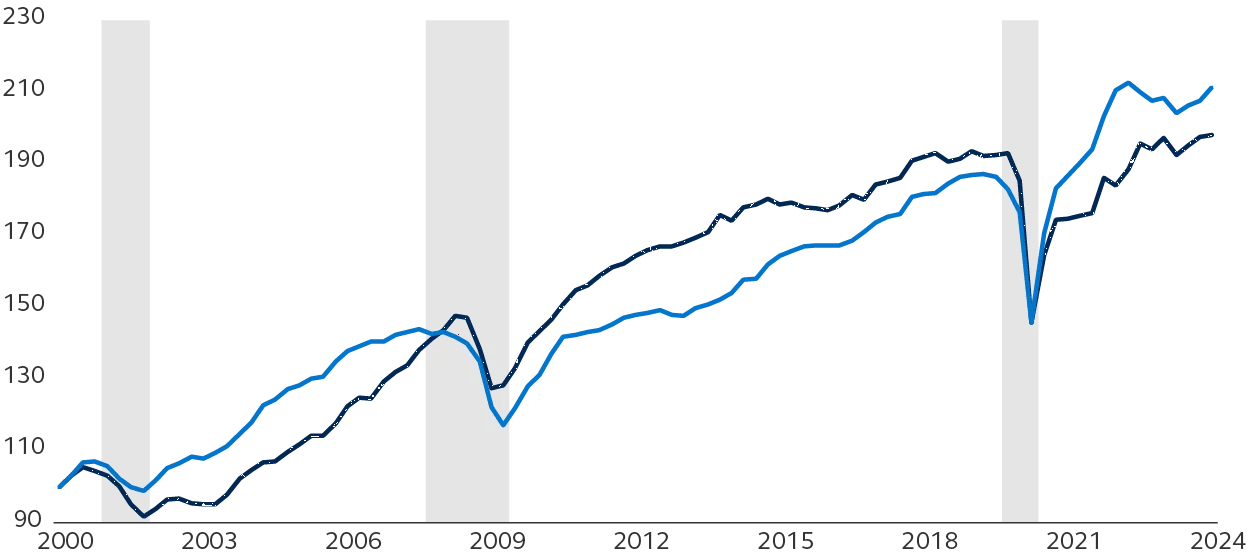
European logistics
Relatively low e-commerce penetration still offers opportunities
E-commerce as share of GDP
Percentage, e-commerce spending in 2023

Waiting for clarity
1. A waiting game
While we anticipated 2024 to be a year of transition, investors have been playing a waiting game as central banks continue their battle with price stability, which has extended uncertainty around pricing in private real estate markets. We continue to believe that a new cycle is forming, and that 2024 and 2025 will offer investors an attractive entry point into private markets. A mature valuation cycle is nearing its end, and a resilient economy continues to support strong demand across most sectors today.
2. Our long-term conviction for structurally-resilient property sectors is unchanged heading into the second half of 2024
Residential, hotel, data center, and logistics sectors will remain underserved in the current growth and demographic environments and have outperformed other sectors this year.
3. Focus on quality and sector selection
We continue to suggest that investors focus on quality and sector selection as keys to effective strategy in 2024, as values begin to stabilize and the path to the recovery comes into view.
Risk Considerations
Investing involves risk, including possible loss of Principal. Past Performance does not guarantee future return. All financial investments involve an element of risk. Therefore, the value of the investment and the income from it will vary and the initial investment amount cannot be guaranteed. Potential investors should be aware of the risks inherent to owning and investing in real estate, including value fluctuations, capital market pricing volatility, liquidity risks, leverage, credit risk, occupancy risk and legal risk. All these risks can lead to a decline in the value of the real estate, a decline in the income produced by the real estate and declines in the value or total loss in value of securities derived from investments in real estate. Data Center properties are only attractive to a unique type of tenant, so a limited tenant base increases the risk of vacancy. Additionally, a property designed to be a data center may be difficult to relet to another type of tenant or convert to another use. Thus, if operating a data center were to become unprofitable, the liquidation value of properties may be substantially less than would be the case if the properties were readily adaptable to other uses.
Important information
This material covers general information only and does not take account of any investor’s investment objectives or financial situation and should not be construed as specific investment advice, a recommendation, or be relied on in any way as a guarantee, promise, forecast or prediction of future events regarding an investment or the markets in general. The opinions and predictions expressed are subject to change without prior notice. The information presented has been derived from sources believed to be accurate; however, we do not independently verify or guarantee its accuracy or validity. Any reference to a specific investment or security does not constitute a recommendation to buy, sell, or hold such investment or security, nor an indication that the investment manager or its affiliates has recommended a specific security for any client account.
Subject to any contrary provisions of applicable law, the investment manager and its affiliates, and their officers, directors, employees, agents, disclaim any express or implied warranty of reliability or accuracy and any responsibility arising in any way (including by reason of negligence) for errors or omissions in the information or data provided.
All figures shown in this document are in U.S. dollars unless otherwise noted. All assets under management figures shown in this document are gross figures and may include leverage, unless otherwise noted. Assets under management may include model-only assets managed by the firm, where the firm has no control as to whether investment recommendations are accepted, or the firm does not have trading authority over the assets.
This material may contain ‘forward looking’ information that is not purely historical in nature. Such information may include, among other things, projections and forecasts. There is no guarantee that any forecasts made will come to pass. Reliance upon information in this material is at the sole discretion of the reader.
This material is not intended for distribution to or use by any person or entity in any jurisdiction or country where such distribution or use would be contrary to local law or regulation.
This document is issued in:
- The United States by Principal Global Investors, LLC, which is regulated by the U.S. Securities and Exchange Commission.
- Europe by Principal Global Investors (Ireland) Limited, 70 Sir John Rogerson’s Quay, Dublin 2, D02 R296, Ireland. Principal Global Investors (Ireland) Limited is regulated by the Central Bank of Ireland. Clients that do not directly contract with Principal Global Investors (Europe) Limited (“PGIE”) or Principal Global Investors (Ireland) Limited (“PGII”) will not benefit from the protections offered by the rules and regulations of the Financial Conduct Authority or the Central Bank of Ireland, including those enacted under MiFID II. Further, where clients do contract with PGIE or PGII, PGIE or PGII may delegate management authority to affiliates that are not authorised and regulated within Europe and in any such case, the client may not benefit from all protections offered by the rules and regulations of the Financial Conduct Authority, or the Central Bank of Ireland. In Europe, this document is directed exclusively at Professional Clients and Eligible Counterparties and should not be relied upon by Retail Clients (all as defined by the MiFID).
- United Kingdom by Principal Global Investors (Europe) Limited, Level 1, 1 Wood Street, London, EC2V 7 JB, registered in England, No. 03819986, which is authorized and regulated by the Financial Conduct Authority (“FCA”).
- United Arab Emirates by Principal Global Investors LLC, a branch registered in the Dubai International Financial Centre and authorized by the Dubai Financial Services Authority as a representative office and is delivered on an individual basis to the recipient and should not be passed on or otherwise distributed by the recipient to any other person or organisation.
- Singapore by Principal Global Investors (Singapore) Limited (ACRA Reg. No. 199603735H), which is regulated by the Monetary Authority of Singapore and is directed exclusively at institutional investors as defined by the Securities and Futures Act 2001. This advertisement or publication has not been reviewed by the Monetary Authority of Singapore.
- Australia by Principal Global Investors (Australia) Limited (ABN 45 102 488 068, AFS Licence No. 225385), which is regulated by the Australian Securities and Investments Commission and is only directed at wholesale clients as defined under Corporations Act 2001.
- This document is marketing material and is issued in Switzerland by Principal Global Investors (Switzerland) GmbH.
- Hong Kong SAR (China) by Principal Asset Management Company (Asia) Limited, which is regulated by the Securities and Futures Commission. This document has not been reviewed by the Securities and Futures Commission.
- Other APAC Countries/Jurisdictions, this material is issued for institutional investors only (or professional/sophisticated/qualified investors, as such term may apply in local jurisdictions) and is delivered on an individual basis to the recipient and should not be passed on, used by any person or entity in any jurisdiction or country where such distribution or use would be contrary to local law or regulation.
Principal Asset Management is the global investment management business for Principal Financial Group® and includes the asset management operations of the following : Principal Global Investors, LLC; Principal Real Estate Investors, LLC; Principal Real Estate Europe Limited and its affiliates; Spectrum Asset Management, Inc.; Post Advisory Group, LLC; Origin Asset Management, LLP; Claritas Investimentos; Principal Global Investors (Europe) Limited; Principal Global Investors (Singapore) Ltd.; Principal Global Investors (Australia) Ltd.; Principal Global Investors (Japan) Ltd.; Principal Asset Management Company (Asia) Ltd., and include assets where we provide model portfolios. Marketing assets under management include certain assets that are managed by Principal International and Retirement and Income Solutions (RIS) divisions of Principal.
Principal Funds are distributed by Principal Funds Distributor, Inc.
© 2024 Principal Financial Services, Inc. Principal®, Principal Financial Group®, Principal Asset Management, and Principal and the logomark design are registered trademarks and service marks of Principal Financial Services, Inc., a Principal Financial Group company, in various countries around the world and may be used only with the permission of Principal Financial Services, Inc. Principal Asset Management℠ is a trade name of Principal Global Investors, LLC. Principal Real Estate is a trade name of Principal Real Estate Investors, LLC, an affiliate of Principal Global Investors.
MM13826-01 | 07/2024 | 3731858–122025



